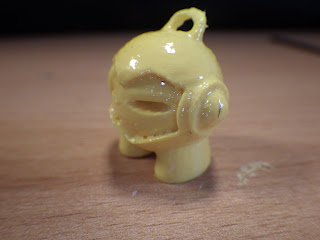So Sometime ago I got a sample of Rigid Inks ABS Filament - Unfortunately you don't get to choose the colour, but at least you get to try out a different supplier.
Here are the results of printing on the UP! Box, Printing our a marvin robot keyring.
Looks pretty good doesn't it.. On the white tiertime filament that comes with the UP! Box printer, it struggled with the key ring loop at the top of the robot, however with the RigidInk filament not a single problem.. It really is amazing as I was expecting the tiertime filament to out perform the Rigid Ink filament considering that the Rigid Ink filament was extruded at the upper end of its temperature range. Also I have been finding the green ABS filament from UP! manufacturer struggles to get going in as much if you put in a reel after the printer has rested, the filament requires an extra bit of pushing to get it to start extruding properly. - Now this is filament that is meant to be compatible with the UP printer (This of course could just be the green filament being the problem, and that any other colour would be fine)..
From my initial Test I am definitely sold on the Rigid Ink Filament, it is a shame that the colours are limited, for instance would be great to have a glow in the dark filament.
I am definetely going to try and get some of their other filament to test - Looks like I should be able to print PMMA and Nylon12 with the standard UP! Box setup - so watch this space!
Oh the final plus of Rigid Ink Filament is the cost - For the filament for UP! Box I have been paying £27 for a 500g reel, Rigid Ink filament is the same price but for double - yes double 1kg reel! Bargain
Oh the final plus of Rigid Ink Filament is the cost - For the filament for UP! Box I have been paying £27 for a 500g reel, Rigid Ink filament is the same price but for double - yes double 1kg reel! Bargain





